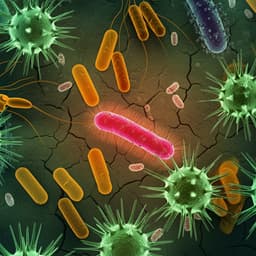
Medicine and Health
To boldly go where no microRNAs have gone before: spaceflight impact on risk for small-for-gestational-age infants
G. Corti, J. K. Kim, et al.
Explore the groundbreaking research conducted by renowned scientists including Giada Corti and Jang Keun Kim, as they unveil the intriguing link between spaceflight stressors and the risk of small-for-gestational-age infants. Discover how miRNA analysis and machine learning could pave the way for potential FDA-approved drug solutions.
Playback language: English
Introduction
The renewed era of space exploration necessitates a thorough understanding of the space environment's effects on human health, particularly for extended deep-space missions. While substantial research exists on spaceflight's impact, a critical gap remains in our understanding of the risks to female reproductive health and the potential consequences for future pregnancies. This study addresses this gap by focusing on the potential link between spaceflight stressors and the increased risk of giving birth to small-for-gestational-age (SGA) infants. SGA infants have birth weights below the 10th percentile for their gestational age, posing significant long-term health risks. The space environment, characterized by ionizing radiation and microgravity, is known to induce various physiological changes, including oxidative stress, DNA damage, and mitochondrial dysregulation. While research has largely focused on male astronauts, the increasing number of women in space exploration necessitates a focus on sex-specific health risks. This research proposes that exposure to space stressors could lead to enduring alterations in female health, increasing the risk of SGA births upon return to Earth. The study uses microRNAs (miRNAs), small non-coding RNAs with regulatory roles in various biological processes, as potential biomarkers and targets for therapeutic interventions. The hypothesis is that a shared miRNA signature exists between SGA births and the effects of the space environment, which can be used to identify and potentially mitigate risks.
Literature Review
Existing literature extensively documents spaceflight-associated health risks in human biology, encompassing oxidative stress, DNA damage, mitochondrial dysregulation, epigenetic changes, telomere dynamics, and microbiome shifts. However, the majority of studies have focused on male participants, leaving a knowledge gap regarding sex-specific risks. Recent studies have begun to address the sex-specific health effects of spaceflight, indicating that women may experience higher risks of premature menopause, reduced fertility, and conditions like endometriosis. Spaceflight-induced changes in estrogen and insulin levels are also of particular concern. The National Academies Decadal Survey has highlighted this research gap, emphasizing the need for further investigation into the space environment's effects on female reproductive systems. The growing body of research on miRNAs as diagnostic biomarkers, their non-invasive sampling, and their involvement in placental-related diseases further supports the relevance of this study. MiRNAs are implicated in various biological processes and have shown aberrant expression in complex pregnancies and fetal growth restriction, suggesting their potential role in SGA development. The conservation of miRNAs across species, including humans and mice, makes them suitable candidates for cross-species studies.
Methodology
The study employed a two-step approach. First, it leveraged data from the ImmPort database (NIAID, NIH) to identify a miRNA signature associated with SGA births. This involved analyzing miRNA profiles in maternal plasma from both SGA and control pregnancies at three different gestational time points. A time-independent analysis was performed to identify consistently altered miRNAs. Second, space biology data from NASA's Open Science Data Repository (OSDR) and GeneLab were utilized to identify miRNAs affected by simulated spaceflight conditions in female C57BL/6 mice. Two datasets were primarily used: OSD-336 (simulated space radiation and microgravity using hindlimb unloading) and OSD-55 (simulated microgravity using a rotating wall vessel bioreactor on human PBLs). The SGA-associated miRNA signature from ImmPort was compared to the spaceflight data to identify shared miRNAs. Pathway analysis was performed using MSigDB Hallmark and MitoCarta databases to determine the biological pathways affected by these miRNAs. To identify potential countermeasures, a machine learning approach (sChemNET) was used to predict FDA-approved small molecule drugs that could target the identified miRNA signature. The study also analyzed RNA-seq data from male and female mice exposed to simulated space radiation to assess long-term impacts. Further, single-nuclei RNA sequencing (snRNA-seq) data from the Inspiration4 mission was analyzed to investigate the effects of spaceflight on miRNA gene targets in human astronauts. The analysis was conducted using a variety of bioinformatics tools and statistical methods, including DESeq2, ggplot2, pheatmap, miRNet, CluePedia, GeneMANIA, and Ingenuity Pathway Analysis (IPA).
Key Findings
The study identified 13 miRNAs shared between SGA births and simulated spaceflight conditions. These miRNAs displayed consistent upregulation (except for miR-146b-5p, which was downregulated) in both datasets. A significant positive correlation (p < 0.05) was observed in miRNA expression between SGA and spaceflight groups for these 13 miRNAs, with two sharing the same seed sequence (miR-29b-3p, miR-29c-3p). These miRNAs exhibited high sequence conservation (pre-miRNA minimum 88% homology, mature miRNA 100% homology) between humans and mice. Pathway analysis revealed that these miRNAs target genes involved in various disease pathways, including those related to birth defects, bone diseases, cardiovascular diseases, diabetes, liver injury, and pulmonary diseases. The miRNAs also target functions related to bone regeneration, angiogenesis, cell cycle, apoptosis, DNA damage and repair, immune system regulation, female reproductive functions, and mitochondrial dysfunction. Analysis of mouse blood samples collected 14 days post-exposure to simulated space radiation showed long-term dysregulation of pathways related to these miRNAs, particularly in female mice. Notably, pathways related to the immune system and mitochondria were suppressed long-term only in female mice. Analysis of the Inspiration4 astronaut data revealed sex-dependent changes in gene expression associated with the 13 miRNAs, with female astronauts showing greater inhibition of gene targets in T cell populations. Machine learning prediction identified several FDA-approved drugs that could potentially target this miRNA signature, including estrogen and progesterone receptor antagonists, vitamin D receptor antagonists, and DNA polymerase inhibitors.
Discussion
The findings suggest a potential link between spaceflight exposure and increased risk of SGA births in female astronauts. The identification of a shared miRNA signature between SGA and spaceflight provides valuable biomarkers for monitoring this risk and potential targets for therapeutic interventions. The high degree of conservation of these miRNAs between humans and mice supports the translational relevance of the findings. The long-term dysregulation of pathways related to these miRNAs in female mice raises serious concerns about the potential persistent effects of spaceflight on female reproductive health. The sex-specific effects observed in the Inspiration4 astronaut data further highlight the importance of considering sex-dependent health risks in space exploration. The identification of potential countermeasures through machine learning opens new avenues for mitigating these risks, potentially reducing the likelihood of SGA births in future space missions. However, it is crucial to note that the study mainly relied on simulated spaceflight conditions and relatively short-duration human spaceflight data. Further research is needed to validate these findings in long-duration space missions involving larger cohorts of female astronauts and to investigate the causality of the identified miRNA signature.
Conclusion
This study provides compelling evidence for a potential link between spaceflight exposure and an increased risk of SGA births in female astronauts. The identification of a conserved miRNA signature shared between SGA and spaceflight conditions offers valuable biomarkers and targets for intervention. The study's findings highlight the importance of incorporating sex-specific analyses in space biology research and underscore the need for further investigation into the long-term effects of spaceflight on female reproductive health. Future research should focus on validating these findings in long-duration space missions, exploring the causality of the identified miRNA signature, and testing the efficacy and safety of the predicted countermeasures in preclinical and clinical settings.
Limitations
The study relies heavily on simulated spaceflight conditions and data from relatively short-duration human spaceflight. The sample sizes, particularly in the human astronaut data, were limited. The study primarily focuses on circulating miRNAs, and it is possible that tissue-specific miRNA expression patterns might differ. The predicted countermeasures need further experimental validation to confirm their efficacy and safety in preventing or mitigating SGA risk in female astronauts. Furthermore, the analysis of the Inspiration4 mission, while providing insights into human responses, is limited by the short duration of the mission compared to long-duration space travel.
Related Publications
Explore these studies to deepen your understanding of the subject.







